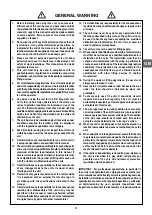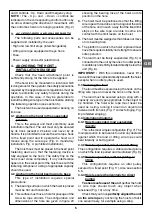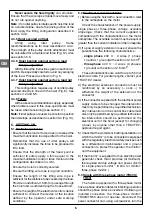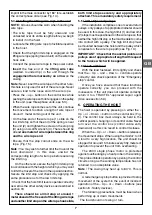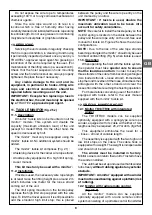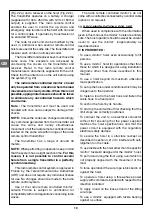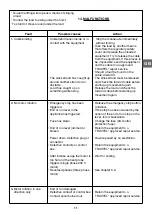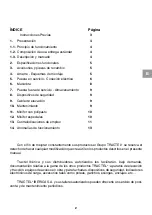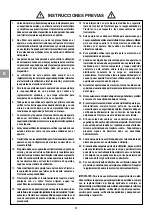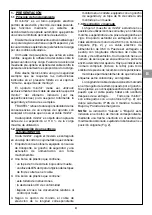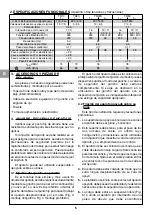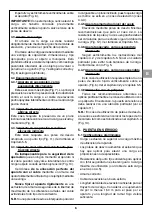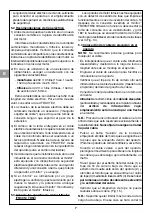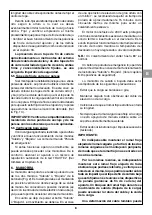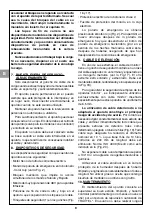
9
Do not expose the wire rope to temperatures
exceeding 100°C or to any corrosive mechanical or
chemical agents.
Store the wire rope wound on its reel in a
location which is free of humidity after having
carefully cleaned and lubricated the wire rope along
its entire length. Do not use grease or oil containing
molybdenum disulphide or graphite additives.
10. SERVICING
Servicing the unit consists in regularly checking
that it is in good condition, in cleaning it and having
it periodically inspected (at least once a year) by a
TRACTEL
®
-approved repair agent. No greasing or
lubrication of the unit is required by the user. (For
maintenance of the lifting wire rope, see section 9).
Check that the hoist suspension hook mounting
screw and the handle locknut are always properly
tightened. Replace these if necessary.
Any visible damage to the unit and its
equipment, in particular its hooks, lifting wire
rope and electrical conductors should be
repaired before resuming use of the unit.
IMPORTANT : Except when replacing a fuse in
the electrical box, the unit must only be opened
by a TRACTEL
®
-approved repair agent.
11. TACKLE MINIFOR
(fig. 25.c)
11.1. Description
A minifor
™
tackle kit can be mounted on all the
minifor
™
models. This system will double the
capacity (maximum utilization load) of the unit
(except for model TR50). On the other hand, the
speed is decreased by half.
The minifor
™
must only be equipped using the
minifor
™
tackle kit. No additional system should be
added.
The minifor
™
tackle kit comprises (Fig. 21) :
• A fastening device for the carrier wire rope strand,
• A tackle pulley equipped with a high limit spring,
• A user manual.
This kit must only be used with a minifor
™
.
11.2. Installation
If tackle is used, the necessary wire rope length
is at least twice the lifting height plus around 2 m
which includes one meter for the loose strand
coming out of the unit.
The limit spring mounted on the tackle pulley
replaces the high limit stop supplied with the wire
rope. To limit the travel upward, it is still possible to
add the standard high limit stop; this is placed
between the pulley and the wire rope entry on the
unit marked by an arrow.
IMPORTANT : If tackle is used, double the
maximum utilization load to be taken into
account for safety calculations.
NOTE : Be careful to install the tackle pulley so that
its limit spring is located on the cable between the
pulley and the wire rope entry on the unit. See user
manual for tackle kit. Figure 25 shows the various
configurations.
NOTE : Due to the risk of the wire rope strands
becoming entangled, the minifor
™
should only be used
for direct vertical lifting (Fig. 5) when tackle is used.
11.3. Operation
When operating the hoist with the tackle system,
the operator must take special care to ensure
that the load does not turn in order to keep the
three strands of the cable from becoming entangled
(two loaded s loose strand). Immediately
stop the load movement if the loose strand becomes
entangled with the other strands and clear the
loose strand before resuming the hoisting operation.
For more details concerning use of the minifor
™
equipped with tackle, refer to the user manual
supplied with the minifor
™
tackle kit.
12. SPECIAL MINIFOR HOIST
12.1 Minifor TR10/TR30 with integrated
winder
The TR10/TR30 models can be supplied
optionally equipped with a spring-type wire rope
winder, equipped with its cable with either of two
lengths as may be required : 20, 27 or 40m. (fig 25.d)
This equipment eliminates the need for a
« loose » strand of variable length.
The assembly is supplied with the two high and
low limit stops on the cable. The cable hook is
equipped with a weight. The weight is indispensable
and should not be removed.
The winder must be installed in factory.
Minifor owners can return their unit to Tractel to have
the winder installed.
The unit must be set up and used so that its winder
turns freely without rubbing against any exterior
obstacle.
IMPORTANT : A minifor
™
equipped with a winder
must not be used bearing against a platform (risk
of rubbing).
12.2 Minifor with radio remote control
(fig. 25.b)
All the minifor
™
models can be supplied
optionally equipped with a radio remote control
system consisting of a portable control transmitter
GB



